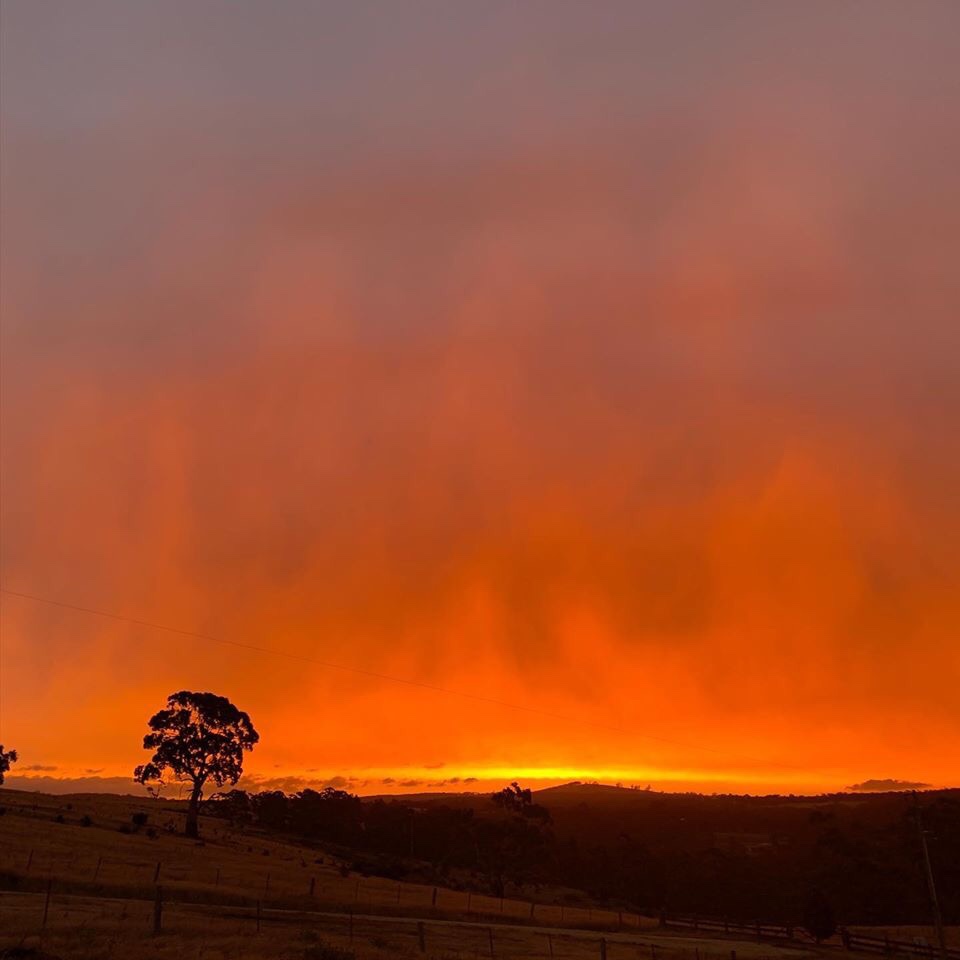We have been surrounded by images of fire, for some weeks now. The last few weeks have been challenging, confronting us with terrible images of devastated landscapes, burnt native animals and birds, destroyed homes, and the bodies of farm stock unable to escape the fire, alongside of pictures and videos of the still-raging flames of fire, leaping high into air, travelling rapidly across the landscape.
We have watched aghast as our screens take us right into the heart of the firestorm, standing with firefighters in the face of unbeatable odds. And we have breathed the air that is saturated with smoke from the fires, smoke that causes us to gasp, cough, and wheeze. It has been a challenging time. And fire has been the constant theme.
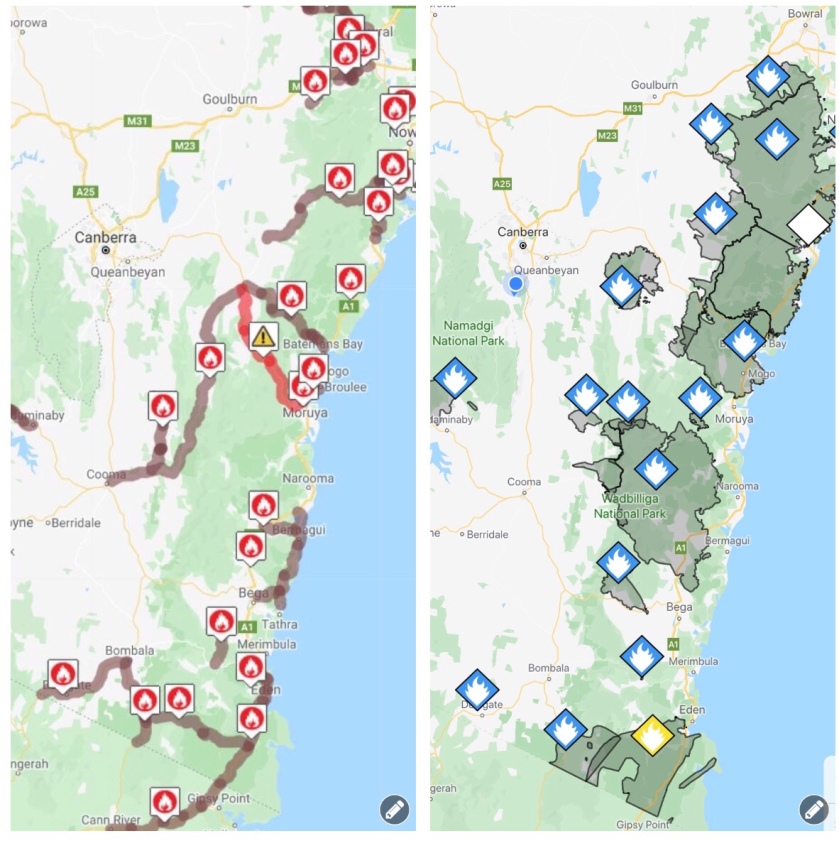
In this context, there is one short verse in the Psalm caught my attention, this week, as I read the lectionary passages and pondered what I would take as a focus for today. I wonder if you noticed the verse that jumped out to me, when we said the psalm together, earlier? “The voice of the LORD flashes forth flames of fire” (Ps 29:7).
These fires that rage, these flames that burn … are they really a message from God, to us, a message of punishment? That is how such events have been seen by some—the bushfires now raging, the floods that swamped North Queensland last year, the five severe cyclones that hit Pacific Islands a few years back, the massive tsunami that ravaged Asian countries over a decade ago—each of these have been explained by some zealous preacher or another, as a sign of God’s punishment.
It was not too long ago that a prominent sports star gained publicity by suggesting that the fires early in the season were sent by God to punish us—punishing us for the many sins committed by people in Australia. Others have made claims that God is punishing us for the decisions made by our church in recent times.
And just a few days ago, a breakaway Baptist pastor in Arizona made the audacious claim that the fires are actually punishment from God because he was denied a visa to visit Australia. He said on Facebook that “maybe if Australia wasn’t banning and deporting preachers of the Gospel, they wouldn’t be under the judgement of God”. And, as you can see, he clearly linked this with the bushfires, using the map of blazes and a picture of one of the fires.
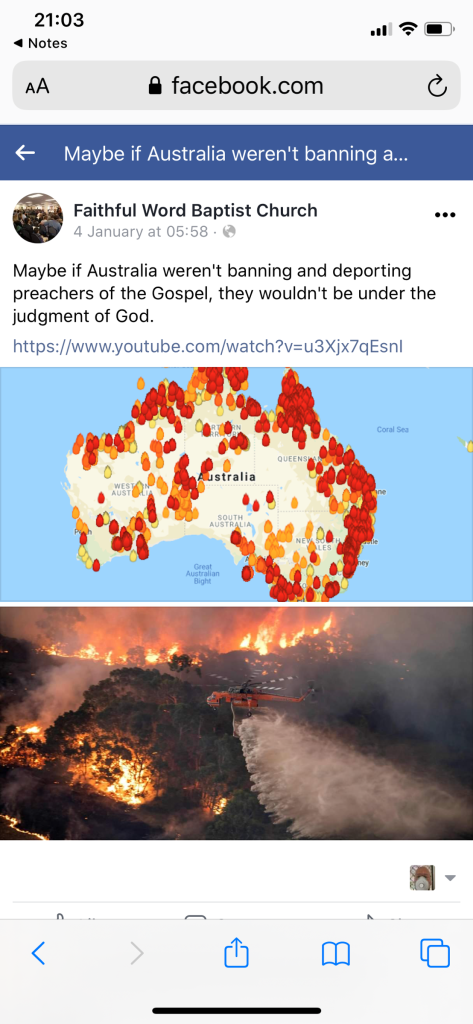
We must, of course, distance ourselves from this kind of simplistic and arrogant claim. Simplistic, because this preacher has been banned from over 20 other countries—and they are not ringed with fire at this time. So a simple cause and effect connection is far too simplistic.
And simplistic, also, because making an interpretation of a naturally-occurring event, and attributing that to the intentions of the deity, is far too easy to do. Our scientific knowledge helps us to have insights as to how events in nature—like fires, storms, cyclones, droughts, and so on—how these actually form and manifest within the natural order of things. Our scientific knowledge also helps us to appreciate how the way that human beings live makes a contribution—however small or significant you believe it may be—to these events of nature.
And such a claim is breathtakingly arrogant in its nature. How can any one of us human beings dare to claim that we know, absolutely and definitively, the intentions of God at any one point in time? And that we can unambiguously declare those intentions?—usually, it must be said, in the voice of an angry prophet, making a negative judgement on the morality of the people.
So I don’t want to go down this track. “The voice of the LORD flashes forth flames of fire” (Ps 29:7) can’t be taken at face value, as a literal, simple explanation of the fires as expressions of divine punishment. Whilst ancient understandings may have made this kind of immediate connection between an event in nature and the intentions of God, we cannot make such a simple link. We need to reflect more deeply.
….
How do we make sense of these fires, when we gather, today, as people of faith? We have seen so many images of the fires. Some of us have been close to the fire front. We have all breathed the smoke generated by those fires. What do they mean?
Some of us have seen this kind of destruction at close quarters. Some have memories of the 2003 Canberra fires brought back to prominent attention. Some have been recently in areas that are now devastated, or have been caught in the early stages of the recent forefront activity.
Some have family members or good friends who have had to evacuate in the face of the fire. Some of us know people whose properties, animals, and houses have been impacted by the intensity of the blazes. We are all caught into a sense of anxiety and grief as the fires continue.
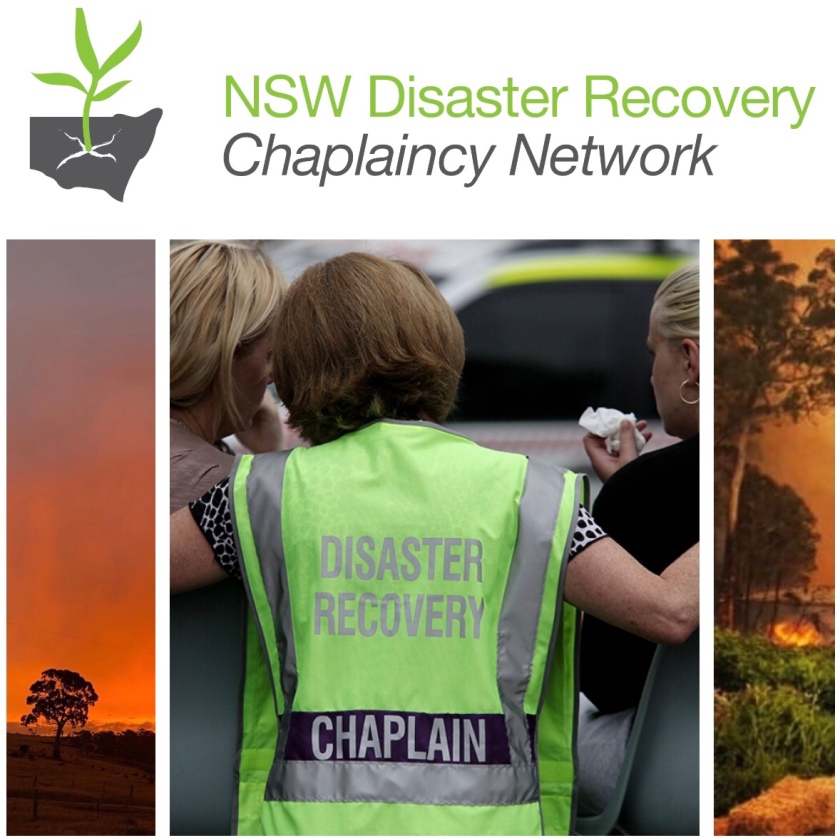
In the evacuation centres, chaplains from a number of different denominations have been present, offering comfort and support to people who have been forced to leave their homes in the face of the fires. A number of my colleagues have been there, for days on end, over recent times, in the midst of people in turmoil, helping them to go gently in the midst of the upheaval and anxiety.
(See https://johntsquires.com/2020/01/09/pastoral-letter-from-canberra-region-presbytery/ and https://johntsquires.com/2020/01/06/what-are-the-churches-doing-during-the-bushfire-crisis/)
For us, at some distance from the fires, we too need to be gentle with each other. We need to hold each other in the comfort of friendship, offer supportive words, provide practical assistance, and sit with each other in the uncomfortable spaces of waiting, wondering, worrying. We need to make sure that we don’t expose ourselves, unnecessarily, to risks to our own health. These fires call us to care, deeply, lovingly.
And yet, there is a question that recurs in situations like I have just described—situations of need, of loss, of intense grief and despair. That is this simple question: where is God? The simple answer—God sent this to you, God is punishing you—does not satisfy. We need another take.
The Adelaide theologian, Dr Norman Habel, wrote a hymn reflecting on just this question, in the context of bushfires that occurred on Black Saturday in 2009. (It goes to the familiar tune of Amazing Grace.) It begins like this:
Amazing flames that scorch the sky, like hurricanes of fire,
Alive with eucalyptus oil are roaring higher and higher.
These swirling balls of oil ablaze that leap o’er trees at will,
Descend on fields and flock and homes, explode and burn and kill.
And then, he asks the question:
Where’s God in all this swirling ash? Where’s God in all this pain?
Awaiting somewhere in the sky to one day send some rain?
The answer comes in striking imagery, in confronting declaration:
The face of God is burnt and black; the hands of God are red!
The God we know in Jesus Christ is bleeding with the dead.
The answer which Norman Habel offers is this: God is here. God is right in the middle of all this mess. God is not remote. God is not the one pulling the strings, away up in heaven, ready to send rain when enough prayers have been sent up to him.
No: God is here, in our midst, incarnate, one with us, suffering alongside us. God is crying as the house burns, weeping as the birds and animals flee, sobbing as the stock die, grieving as the firefighters are overwhelmed and their truck is overturned. God is here, with us. Jesus Christ is bleeding with the dead, grieving with us, mourning with creation.
The last verse of the hymn, then, is this:
Christ, show us now your hands and feet, the burns across your side,
and how you suffer with the Earth, by fires crucified!

And this reminds me of the poem that I shared with you some months back, about how we encounter God, and where we encounter God. The poem by Lisa Jacobson expresses the clear notion that God is not up there in the heavens, as the priest might claim, but down here in the land, as the black fella would say. To find God, we need to look for God; but not look up, to the heavens; rather, look down, look at your feet, look past your feet, to the stones—hear them singing? and the rivers—feel them vibrating? And sense how the earth is yearning, groaning.
Stones singing and rivers vibrating; that twofold expression of the inner life of the earth is also the key that unlocks a different understanding of God—as a being not remote and removed from humans on earth, but as a being beside us, around us, underneath us, in the earth, in the stones, in the rivers, in our very being.
And this, of course, is rightly acknowledged in this poem, as the insight of black fellas—the centre of spirituality for the First Peoples of this ancient continent, the heart of life and spirit for the Ngunnawal people, the people who have cared for the land in this general region from time beyond what we can measure, and for the Ngambri and Ngarigo people more locally, and for the Wiradjuri to our west, and for the first peoples of every city and region across this continent. God is in the land, God is in amongst us.
This understanding of where we find God, how we enter the depths of spirituality, is set forth very clearly in a clause of the Revised Preamble to the Constitution of the Uniting Church, which clearly affirms:
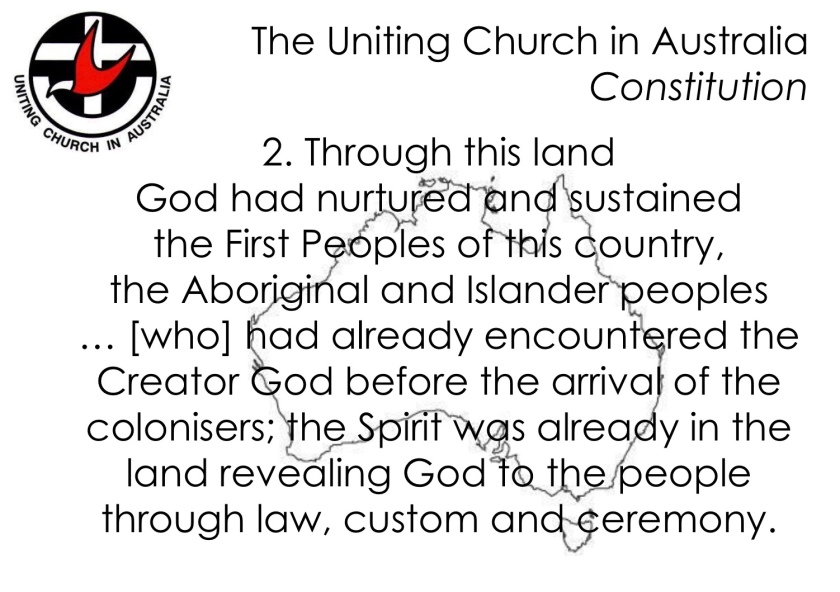
So we have adopted an affirmation that when we hear the stones sing, when we feel the rivers vibrating, we are connecting in a new way, with God, who is here, and has long been here, in this land, the land which God created at the first.
This claim arises from a different way of thinking about God, pondering the claims of scripture and engaging us on a journey of reflection and prayer, exploration and discovery, at the edges of our faith. Both the Australian poem and indigenous Australian spirituality have taken hold of this insight, that God is in our midst, amongst us, within us.
That is the same claim that the Gospel writer makes, when he writes that the angel told Joseph that he was to name his child Emanuel—God with us (Matt 1). That is what that child, grown to be an adult, taught about the reign of God—that it was here, in our midst—the kingdom of God is within us (Luke 17).
That is what the ancient Hebrew psalmist affirmed, about the whole of creation—humans, animals, insects, birds, mountains and valleys, trees and forests—that when God created this whole creation, it was the spirit of God that was breathed into every living creature (Ps 104:30).
And the psalm we have read today affirms that God is active and at work in the creation. He is not an absentee, uninterested, disconnected God. God is active, over the oceans, in the desert, through the forests, in thunder and flames. God is here, with us.
And this, after all, is the story that we tell, and retell, each year, each Sunday: the story of God, come to us in the human being Jesus, friend of sinners and advocate for the outcast, Jesus arrested and condemned as a criminal, Jesus, despised, crucified, hanging on the cross. That is where God was to be found, most profoundly, most assuredly—in the very midst of our life.
And as Jesus suffers and dies, so God suffers, and feels the sharpness of the moment we call death. For that is where God is. Here, in our midst, amongst us.

Just as God is with us, in the midst of our lives, in the midst of this creation, present in the animals and humans, the ecosystems and great forests, so also God suffers with the earth, as part of the earth. So, for me, the psalm does, indeed, speak a truth—a confronting, challenging, disturbing truth.
For the fires we are experiencing now are the result of the way that human beings, collectively, have been living, not just this year, or for a few years, but for many years—for centuries. The clear observations of science are, that as we have industrialised our societies and pumped more CO2 into the atmosphere, we have developed an environment that is drier, and hotter; more vulnerable to firestorms and more liable to flooding; for the creation is groaning, it is out of order.
And in the processes of nature that are at work, that we have intensified and exacerbated, we see tragic results in the multiple fire fronts that have surged in recent weeks—just as the same instability in the earth’s system has generated more intense and more frequent cyclones, warmed the oceans and melted the edges of the polar caps, and other observable events around the world.
And in the midst of those cyclones, and meltings, and bleachings of coral, and eruptions of fire storms, God is communicating with us: the world cannot go on like this, the planet can not sustain our incessant disregard for its natural ways. So, yes, I think that the psalmist does speak truth. The voice of the LORD flashes forth flames of fire.
God has not singled out a nation, or a people, or particular individuals for punishment. God, indeed, is not manipulating what occurs, intervening whenever and however God wills. God is in the systems, in the processes of our natural environment, and as the fires rage, God is indeed speaking to us through those flames of fire. The challenge, for us, is to pause … to listen … to understand … and to act in response.
Thanks to Dr Byron Smith for this prayer in response: https://www.commongrace.org.au/prayer_for_bushfires, to Dr Sarah Agnew for this lament: http://sarahtellsstories.blogspot.com/2020/01/choking.html, and to the Rev. Jennie Gordon for this blessing: https://greaterfarthantongueorpen.wordpress.com/about/
For my other blogs on the environment, see
https://johntsquires.com/2019/06/25/873/
https://johntsquires.com/2019/05/05/to-care-for-honour-and-respect-the-creation-we-need-to-stopadani-k/
https://johntsquires.com/2019/03/09/laudato-si-mi-signore-1/
https://johntsquires.com/2019/03/09/laudato-si-mi-signore-2/
https://johntsquires.com/2019/03/09/laudato-si-mi-signore-3/
https://johntsquires.com/2019/03/09/laudato-si-mi-signore-4/
My wife Elizabeth Raine has written some helpful reflections on environmental theology at
And God saw it was good…
and
http://ruralreverend.blogspot.com/2012/06/musing-on-ecological-economy-why.html
and a series of blogs on living a life with low environmental impact, at
http://ruralreverend.blogspot.com/2013/10/setting-sail-on-ss-low-impact.html
http://ruralreverend.blogspot.com/2013/10/rubbish-to-left-of-me-and-rubbish-to.html
http://ruralreverend.blogspot.com/2014/07/planet-at-risk-sorry-for-inconvenience.html
http://ruralreverend.blogspot.com/2014/10/hygenically-sealed-in-plastic-for-your.html
and a lot more at https://elementcityblog.com (follow the links on the right of the page)




